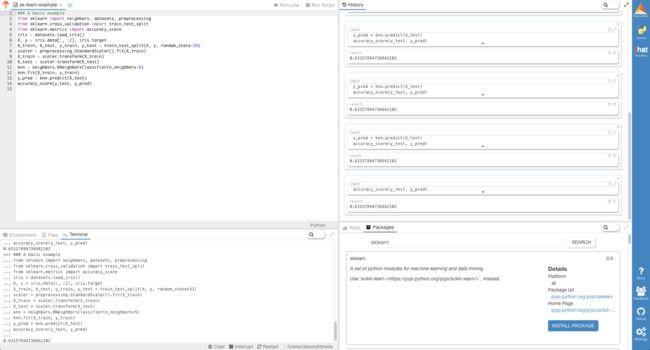Scikit-Learn备忘单:Python机器学习
由Karlijn Willems | 一月12,2017 (by Karlijn Willems | January 12, 2017)
This post originally appeared on the DataCamp blog. Big thanks to Karlijn and all the fine folks at DataCamp for letting us share with the Yhat audience!
该帖子最初出现在DataCamp博客上 。 非常感谢Karlijn和DataCamp的所有优秀人士,让我们与Yhat的读者分享!
Scikit-Learn库 (Scikit-Learn library)
Most of you who are learning data science with Python will have definitely heard already about scikit-learn, the open source Python library that implements a wide variety of machine learning, preprocessing, cross-validation and visualization algorithms with the help of a unified interface.
绝大多数使用Python学习数据科学的人肯定已经听说过scikit-learn这个开源的Python库,该库通过一个统一的界面来实现各种机器学习,预处理,交叉验证和可视化算法。
If you’re still quite new to the field, you should be aware that machine learning, and thus also this Python library, belong to the must-knows for every aspiring data scientist.
如果您还不熟悉该领域,那么您应该意识到,机器学习以及这个Python库都是所有有抱负的数据科学家必知的知识。
That’s why DataCamp has created a scikit-learn cheat sheet for those of you who have already started learning about the Python package, but that still want a handy reference sheet. Or, if you still have no idea about how scikit-learn works, this machine learning cheat sheet might come in handy to get a quick first idea of the basics that you need to know to get started.
这就是为什么DataCamp为已经开始学习Python软件包但仍然需要方便的参考表的那些人创建了scikit-learn速查表的原因。 或者,如果您仍然scikit-learn工作原理,则此机器学习备忘单可能会派上用场,以使您快速了解入门所需的基础知识。
Either way, we’re sure that you’re going to find it useful when you’re tackling machine learning problems!
无论哪种方式,我们都可以肯定,当您解决机器学习问题时,它将发现它很有用!
This scikit-learn cheat sheet will introduce you to the basic steps that you need to go through to implement machine learning algorithms successfully: you’ll see how to load in your data, how to preprocess it, how to create your own model to which you can fit your data and predict target labels, how to validate your model and how to tune it further to improve its performance.
这份scikit-learn备忘单将向您介绍成功实现机器学习算法所需的基本步骤:您将看到如何加载数据,如何对其进行预处理,如何创建自己的模型。您可以拟合数据并预测目标标签,如何验证模型以及如何对其进行进一步调整以提高其性能。
In short, this cheat sheet will kickstart your data science projects: with the help of code examples, you’ll have created, validated and tuned your machine learning models in no time.
简而言之,该备忘单将启动您的数据科学项目:借助代码示例,您将立即创建,验证和调整您的机器学习模型。
你在等什么? (What are you waiting for?)
Time to get started!
是时候开始了!
You might begin with DataCamp’s scikit-learn tutorial for beginners, in which you’ll learn in an easy, step-by-step way how to explore handwritten digits data, how to create a model for it, how to fit your data to your model and how to predict target values. In addition, you’ll make use of Python’s data visualization library matplotlib to visualize your results.
您可能会从DataCamp的面向初学者的scikit-learn教程开始,在该教程中,您将以简单,分步的方式学习如何探索手写数字数据,如何为其创建模型,如何将数据适合您的模型以及如何预测目标值。 另外,您将利用Python的数据可视化库matplotlib可视化您的结果。
You can also just jump right into running the code examples provided on the cheat sheet. If you want to jump right into coding, be sure to also check out Yhat’s data science IDE, Rodeo. If you’ve ever worked in RStudio, it’s a very similar setup. You can download Rodeo for Windows, Mac or Linux here. Fun fact: as of v2.5.2, the Windows version comes with Python built-in (since installing Python on Windows can really be a pain.) Specifically, Rodeo ships with Continuum’s Miniconda. You can read more about that here.
您也可以直接运行备忘单上提供的代码示例。 如果您想直接进行编码,请确保还查看Yhat的数据科学IDE Rodeo 。 如果您曾经在RStudio工作过,那将是非常相似的设置。 您可以在此处下载适用于Windows,Mac或Linux的Rodeo。 有趣的事实:从v2.5.2开始,Windows版本内置了Python(因为在Windows上安装Python确实很麻烦。)特别地,Rodeo附带了Continuum的Miniconda。 您可以在这里阅读更多有关它的信息 。
Rodeo is a convenient environment for data exploration and analysis with packages like Scikit-Learn
Rodeo使用Scikit-Learn等软件包为数据探索和分析提供了便利的环境
翻译自: https://www.pybloggers.com/2017/01/scikit-learn-cheat-sheet-python-machine-learning/

